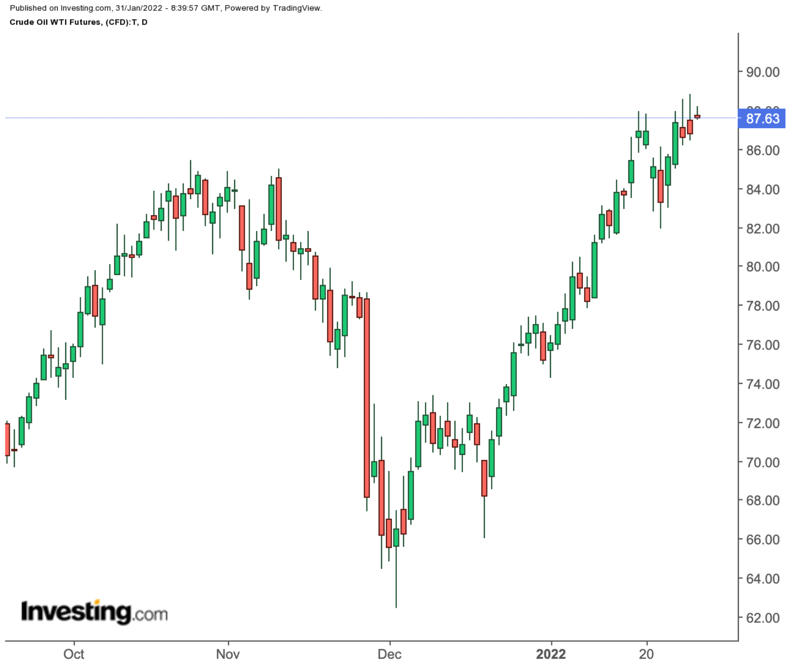Asia tech stocks slide tracking Wall St losses amid AI doubts, govt. uncertainty
The Russia-Ukraine political theater and OPEC’s likely reminder that it won’t meet its production targets should keep crude prices at or near $90 a barrel this week as the buying mania in oil continues for a seventh straight week.
In the case of gold, the challenge will be to not stray far from the key $1,800 mark amid chatter from Goldman Sachs that there could be as many as five US rate hikes this year, instead of the three to four expected by markets. Atlanta Fed chief Raphael Bostic also dropped a bombshell at the weekend that some rate increases could be as large as a half percentage point, versus max forecasts for a quarter-percentage point rise each time.
Oil began Monday’s trading higher again in Asia, on track to an average January gain of 16% for the London-traded global crude benchmark Brent and New York-traded West Texas Intermediate (WTI) for US crude. It was the highest average gain for oil prices in a month since February 2021.
“Bottom line is that everything that I look at tells me oil can go a lot higher,” Scott Shelton, crude futures broker at ICAP in Durham, North Carolina, said ahead of the weekend.
“Refiners can reach for barrels here at this price … margins will justify it.”
However, Shelton added that he thought “a smaller flat price is better suited for this story,” suggesting an overrun in crude prices.
As of Friday, crude prices posted a sixth straight weekly win, with global benchmark Brent printing a new $90 peak at $90.25. Brent is up 15% for January so far.
WTI hit a seven-year high of $88.84 on Friday. The US crude benchmark has risen 17% for January.
Last week’s rally in oil was fueled again by Eastern European tensions, courtesy of the Russia-Ukraine conflict—which reached a new high after Moscow’s military buildup near Ukraine expanded to include blood supplies that would allow it to treat casualties. It was another indicator of the Kremlin's military readiness in the conflict, three US officials told Reuters.
Oil: OPEC+ Drama Adds to Ukraine’s
This week, OPEC+ is readying for its Feb. 2 monthly meeting. The 26-nation OPEC+ is led by Saudi Arabia—which runs the original 13-member Organization of the Petroleum Exporting Countries—and Russia, which steers a group of another 10 non-OPEC countries that includes itself.
Since the end of 2020, OPEC+ has used every one of its meetings as an opportunity to ramp up oil prices with talk of either production cuts or inability to meet demand. In recent weeks, the energy media has been saturated with reports that oil exporters in the alliance were unable to add to production due to capacity constraints from under-invested oil fields.
At its Feb. 2 meeting, OPEC+ is likely to stick with a planned rise in its oil output target for March, several OPEC+ sources told Reuters. But the higher production target wouldn’t matter when there is a perception that the alliance simply cannot pump more.
But OPEC+ is also guilty of calling an undersupplied market “balanced,” said John Kilduff, founding partner at New York energy hedge fund Again Capital. He was referring to the alliance’s refusal to add meaningfully to output last year when it had better means to do so. Then OPEC+ batted away calls by the United States, China, and India to add more barrels to the market as those economies were experiencing dynamic recovery from the coronavirus pandemic. The alliance’s excuse then: Oil markets were “balanced.”
“OPEC+ called the oil market balanced but ensured it never reached balance, because true balance could mean $60 oil, not $90,” said Kilduff.
Some analysts actually anticipate a severe shortage of petroleum this year. Reuters columnist John Kemp is one, noting that inventories were already low and there was little global spare capacity to raise production in the short term.
ANZ Research also says its research shows a market in deficit, with low inventories. It added that "supply constraints will likely induce a sizable risk premium" as air travel picks up, particularly in Europe.
Gold Heads For January Loss
Gold, meanwhile, heads for a monthly loss of just over 2% as trading for January heads to a close on Monday.
Gold futures’ most active contract on New York’s COMEX, February, was up $2.30, or 0.1%, to $1,787.20 an ounce at the time of writing.
But in three previous sessions to Friday, the benchmark gold futures contract fell almost $70, leaving it with a weekly loss of more than 2% that resulted in January’s underperformance. Earlier last week, COMEX’s front-month topped $1,854—its highest since November and in a convincing break from the $1,830-$1,835 resistance.
The three-day tumble that followed has taken it back below that resistance, making that a tougher wall now for gold to climb.
Sunil Kumar Dixit, chief technical strategist at skcharting.com, said the price action over the week showed gold's next move will largely depend on the market's reaction to the $1,780 level, whether it’s a holding or breaking point.
“Breaking and sustaining below $1,780 will extend the bearish momentum, exposing vulnerability towards $1,768 and $1,735,” added Dixit.
Disclaimer: Barani Krishnan uses a range of views outside his own to bring diversity to his analysis of any market. For neutrality, he sometimes presents contrarian views and market variables. He does not hold a position in the commodities and securities he writes about.
